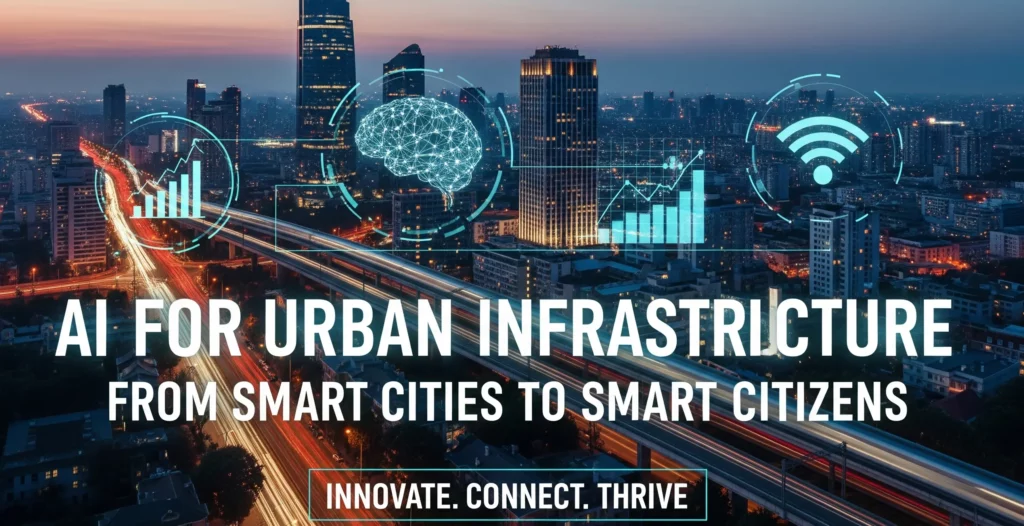1. Introduction
India is urbanising at a historic pace: about 37% of the population lived in cities in 2024 (≈535 million people), and the share is expected to cross 40% by 2030, making it urgent to strengthen urban services and governance so cities deliver reliable, citizen-centred outcomes. Launched in 2015, the Smart Cities Mission (SCM) selected 100 cities to pilot technology-enabled improvements in mobility, waste, water, safety, and e-governance; all 100 now operate Integrated Command & Control Centres (ICCCs), and roughly 9,001 projects have been sanctioned with around 94% completed as of mid-2025. ICCCs stitch together data from sensors, cameras, and citizen apps, using AI, IoT, and analytics to manage city operations in near real time, yet congestion, uneven waste services, and reactive planning still affect daily life—precisely where AI is beginning to make a measurable difference.
2. Background of Urban Infrastructure in India
- Rapid urban population growth: The urban share was ~37% in 2024 and is projected to exceed 40% by 2030, reinforcing the need for resilient, scalable urban systems.
- Smart Cities platform: All 100 ICCCs are live and a large project pipeline is substantially delivered, creating a strong digital backbone for city operations.
- Reality check: Core municipal functions—traffic, waste, and planning—require deeper AI-enabled transformation so everyday citizen experience improves consistently.
3. Key Challenges (India’s Urban Reality, Briefly)
- Traffic congestion & unreliable travel times: Peak-hour speeds in major metros are among the world’s slowest, so commuters lose dozens of hours annually to congestion, which harms productivity, worsens air quality, and undermines road safety.
- Solid waste management gaps: Urban India generates ~62 million tonnes of municipal solid waste each year, and uneven collection and processing lead to overflows, open dumping, and continued landfill dependence that hurt health and the environment.
- Planning, housing & service deficits: Rapid growth is outpacing planning capacity; zoning enforcement is patchy and infrastructure and affordable housing often lag demand, so cities must plan smarter for land use, mobility, water, and resilience as the urban share approaches ~50% by 2050.
4. How AI Is Addressing These Challenges
4.1 Traffic Management (from gridlock to flow)
4.1.1 What AI does (plain terms):
- Predictive analytics learn from GPS and CCTV feeds to forecast bottlenecks and propose diversion plans that keep traffic moving.
- Adaptive signal control uses computer vision or loop detectors to adjust green times dynamically and form “green waves” along busy corridors.
- Automated enforcement & incident detection flag red-light jumps, speeding, stalled vehicles, and crashes so response teams can act faster.
4.1.2 Citizen value: Commutes become shorter and more predictable, accident risks fall, and emergency response reaches the scene faster.
4.2 Waste Monitoring & Management (from overflow to on-time pickup)
4.2.1 What AI does:
- Smart bins & sensors report fill levels so pickups are triggered before overflow.
- AI route optimisation sequences trucks using live bin, vehicle, and traffic data to cut dead miles and fuel use.
- Computer-vision sorting identifies materials at facilities to raise recovery rates and improve recycling yields.
4.2.2 Citizen value: Streets stay cleaner, missed pickups drop, and municipal budgets stretch further through fuel and route efficiencies.
4.3 Urban Planning (from reactive to data-driven)
4.3.1 What AI does:
- GeoAI on satellite imagery tracks urban expansion, detects informal growth, and highlights service gaps so investments can be targeted where they will matter most.
- Digital twins simulate “what-if” scenarios—such as new roads, drainage upgrades, or zoning changes—so planners can test outcomes before committing funds.
4.3.2 Citizen value: Land is used more intelligently, layouts become safer against floods, essential services are sited more effectively, and planning decisions gain transparency and credibility.
5. What’s the Value Added for Citizens?
- Time and cleaner air: Better traffic flow trims commute times and idling emissions, easing stress while improving local air quality.
- Safer streets: ICCC-integrated, AI-assisted policing and faster incident response reduce crime and crashes, improving everyday safety.
- Cleaner neighbourhoods: IoT-enabled bins and AI-optimised routes prevent overflow and improve collection reliability, which is essential for dignity and public health.
- More responsive city halls: Real-time dashboards help teams fix potholes, clear waterlogging, and reroute services before minor issues escalate into disruptions.
6. From Smart Cities to Smart Citizens (What to Scale Next)
- Invest in digital backbones: Expand connectivity, sensor networks, and secure compute and storage so AI systems can operate reliably at city scale.
- Build skills inside ULBs: Train municipal teams in data engineering, analytics, and AI operations, and co-create solutions with academia and startups.
- Standardise privacy & ethics: Adopt clear data-governance rules for CCTV and IoT—covering purpose limitation, retention, and audits—to sustain public trust.
- Package replicable toolkits: Convert Smart Cities learnings into plug-and-play templates—signal control, waste VTMS, and grievance dashboards—so tier-2/3 cities can adopt quickly.
- Use digital twins for resilience: Pilot ward-level twins to plan drainage, transport, and heat mitigation, drawing on early Indian precedents to accelerate uptake.
7. Conclusion
AI in Indian cities has moved beyond pilots: green-wave signals are shaving minutes off commutes, ICCC-guided waste fleets are keeping streets clean, and GeoAI is helping planners get ahead of floods and sprawl. By reinforcing infrastructure, building skilled municipal teams, governing data ethically, and engaging citizens, India can scale what works; the payoff is direct and human—shorter trips, cleaner neighbourhoods, safer streets, and services that arrive before problems do

